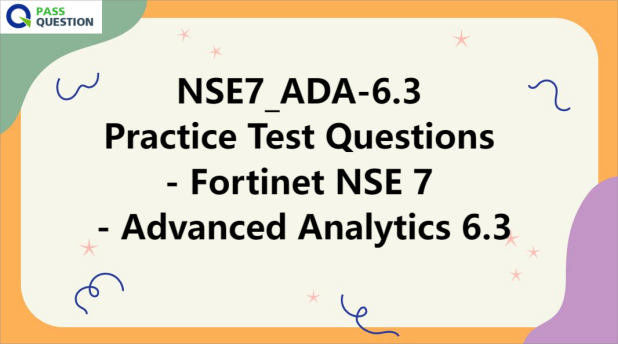NSE7_ADA-6.3 Practice Test Questions - Fortinet NSE 7 - Advanced Analytics 6.3
Passing the Fortinet NSE 7 - Advanced Analytics 6.3 exam is a crucial step for network and security professionals responsible for managing, configuring, administering, monitoring, and securing the networks of a customer's organization. PassQuestion provides the latest NSE7_ADA-6.3 Practice Test Questions to help candidates pass the Fortinet NSE 7 - Advanced Analytics 6.3 exam easily. The NSE7_ADA-6.3 Practice Test Questions are designed to simulate the actual exam environment, which helps candidates develop the skills and confidence required to ace the exam. With a comprehensive understanding of the exam objectives and a thorough preparation strategy, candidates can pass the exam with confidence.

NSE7_ADA-6.3 Exam Overview - Fortinet NSE 7 - Advanced Analytics 6.3 Exam
Fortinet's NSE 7 Network Security Architect program is designed for network and security professionals responsible for managing, configuring, administering, monitoring, and securing networks using FortiSIEM and FortiSOAR devices. The Fortinet NSE 7 - Advanced Analytics 6.3 exam is a part of this program, which tests the candidate's knowledge and expertise in FortiSIEM and FortiSOAR devices in SOC or MSSP environments.
The Fortinet NSE 7 - Advanced Analytics 6.3 exam is intended for network and security professionals responsible for managing, configuring, administering, monitoring, and securing networks of a customer's organization. The exam tests the applied knowledge of FortiSIEM configuration, operation, and troubleshooting scenarios, including operational scenarios, incident analysis, and integration with FortiSOAR.
Exam Details
Exam name: Fortinet NSE 7 - Advanced Analytics 6.3
Exam series: NSE7_ADA-6.3
Time allowed: 60 minutes
Exam questions: 35 multiple-choice questions
Scoring Pass or fail, a score report is available from your Pearson VUE account
Language: English
Product version: FortiSIEM 6.3.0, FortiSOAR 7.0.1, FortiOS 7.0.1
Exam Objectives
The Fortinet NSE 7 - Advanced Analytics 6.3 exam evaluates the candidate's knowledge and skills in multiple areas and tasks. Successful candidates have applied knowledge and skills in the following areas and tasks:
Multi-Tenancy SOC Solution for MSSP
The successful candidate should be able to describe multi-tenancy solutions for the SOC environment, define and deploy collectors and agents, and install and manage FortiSIEM Windows and Linux agents.
FortiSIEM Rules
The successful candidate should be able to explain FortiSIEM rule processing, construct FortiSIEM rules, and explain the MITRE ATT&CK framework.
FortiSIEM Baseline and UEBA
The successful candidate should be able to explain FortiSIEM baseline and profile reports, construct FortiSIEM baseline rules, and configure UEBA on FortiSIEM.
Clear Conditions and Remediation
The successful candidate should be able to remediate incidents on FortiSIEM manually and automatically and remediate incidents using FortiSOAR.
View Online Fortinet NSE 7 - Advanced Analytics 6.3 NSE7_ADA-6.3 Free Questions
1. Why can collectors not be defined before the worker upload address is set on the supervisor?
A.Collectors can only upload data to a worker, and the supervisor is not a worker
B.To ensure that the service provider has deployed at least one worker along with a supervisor
C.Collectors receive the worker upload address during the registration process
D.To ensure that the service provider has deployed a NFS server
Answer: C
2. What is Tactic in the MITRE ATT&CK framework?
A.Tactic is how an attacker plans to execute the attack
B.Tactic is what an attacker hopes to achieve
C.Tactic is the tool that the attacker uses to compromise a system
D.Tactic is a specific implementation of the technique
Answer: B
3. From where does the rule engine load the baseline data values?
A.The profile report
B.The daily database
C.The profile database
D.The memory
Answer: C
4. Which syntax will register a collector to the supervisor?
A.phProvisionCollector --add
B.phProvisionCollector --add
C.phProvisionCollector --add
D.phProvisionCollector --add
Answer: B
5. Which three processes are collector processes? (Choose three.)
A.phAgentManaqer
B.phParser
C.phRuleMaster
D.phReportM aster
E.phMonitorAgent
Answer: B, C, E
6. Which three statements about collector communication with the FortiSIEM cluster are true? (Choose three.)
A.The only communication between the collector and the supervisor is during the registration process.
B.Collectors communicate periodically with the supervisor node.
C.The supervisor periodically checks the health of the collector.
D.The supervisor does not initiate any connections to the collector node.
E.Collectors upload event data to any node in the worker upload list, but report their health directly to the supervisor node.
Answer: B, C, E
7. Which statement about EPS bursting is true?
A.FortiSIEM will let you burst up to five times the licensed EPS once during a 24-hour period.
B.FortiSIEM must be provisioned with ten percent the licensed EPS to handle potential event surges.
C.FortiSIEM will let you burst up to five times the licensed EPS at any given time, provided it has accumulated enough unused EPS.
D.FortiSIEM will let you burst up to five times the licensed EPS at any given time, regardless of unused of EPS.
Answer: C
- TOP 50 Exam Questions
-
Exam
All copyrights reserved 2025 PassQuestion NETWORK CO.,LIMITED. All Rights Reserved.

